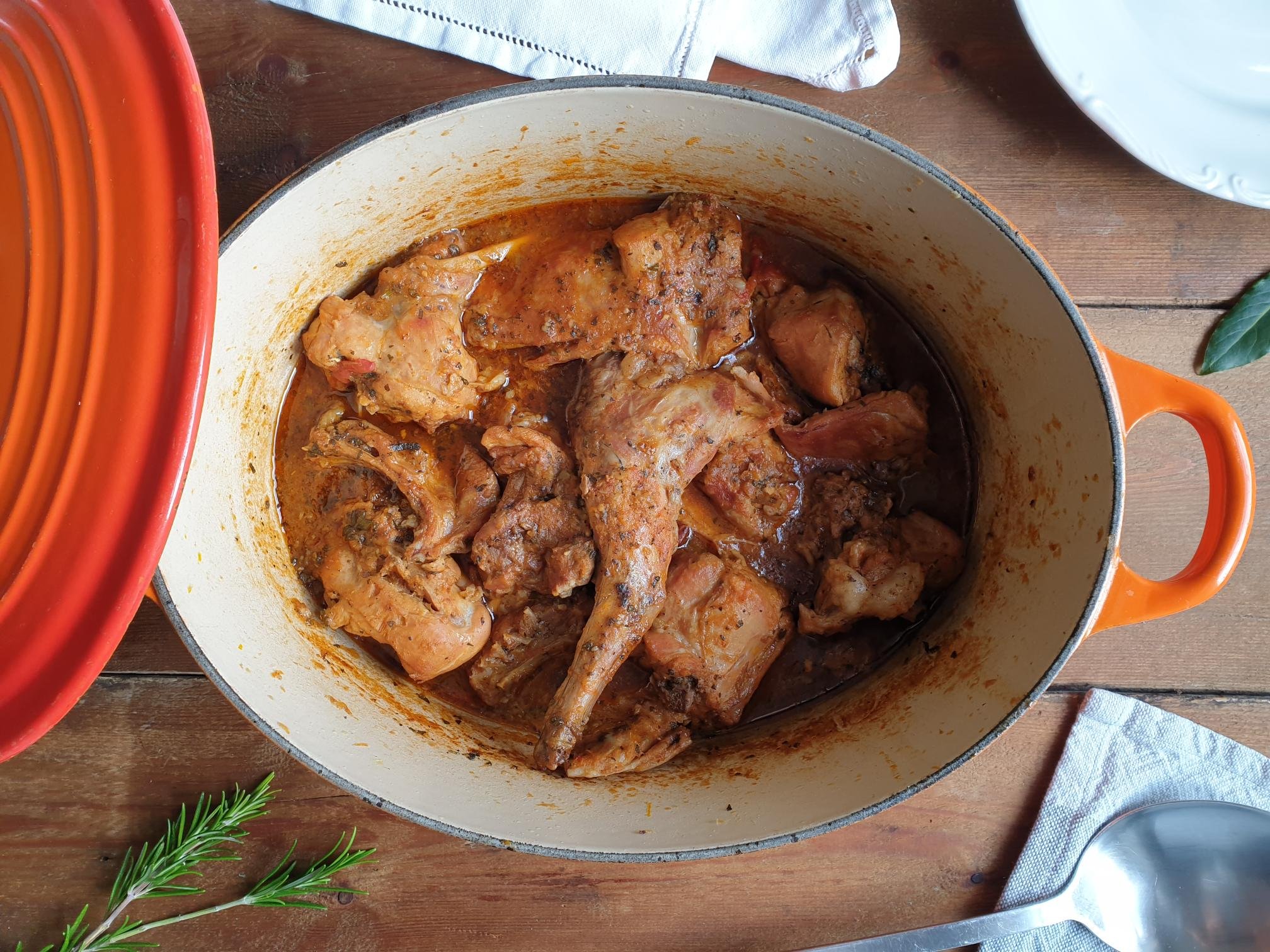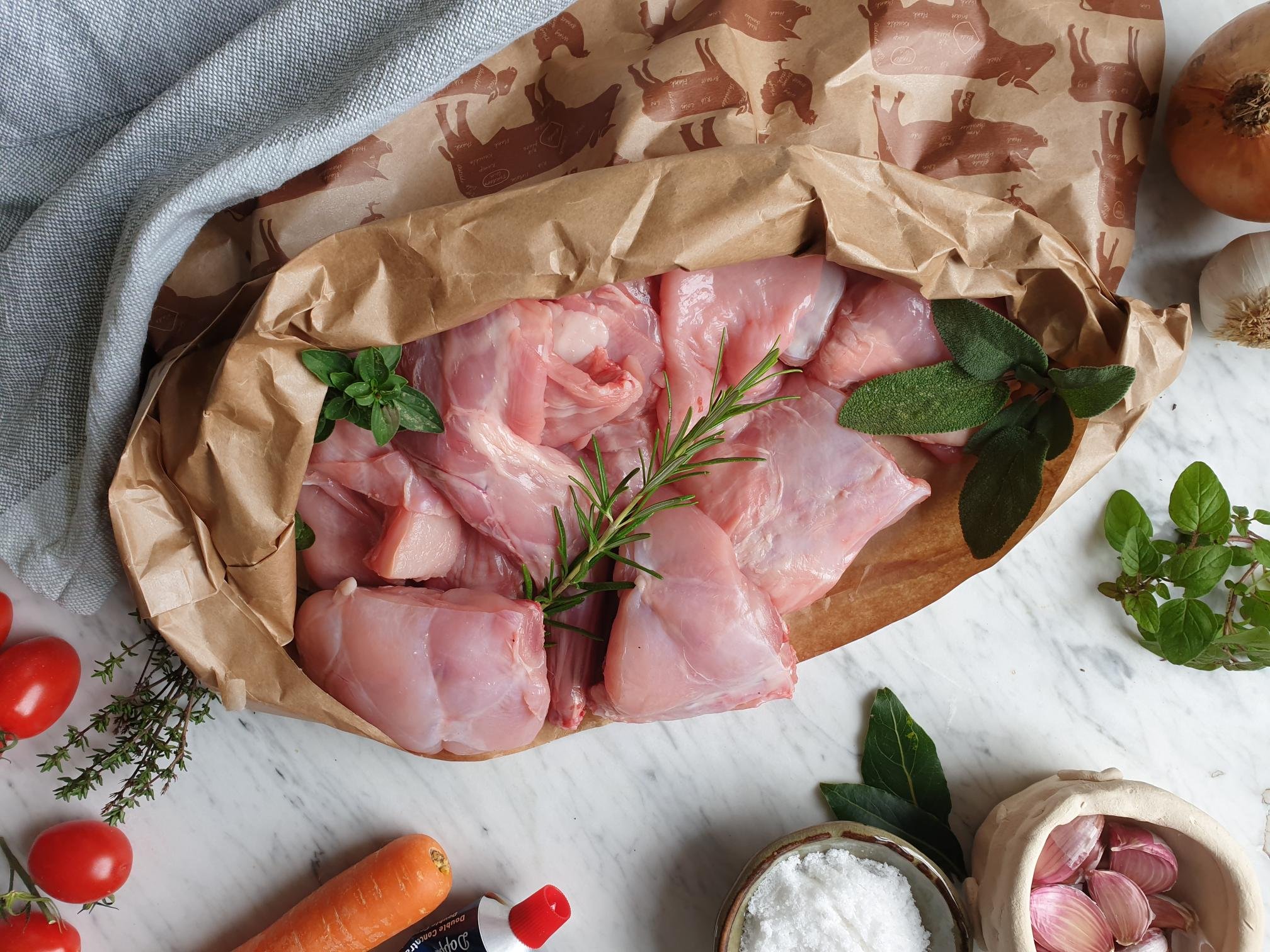Rabbit Goulash Istrian Recipe
Rabbit goulash is a hearty, peasant meal, and a real comfort dish for the coming cold winter evenings. It is made with only few ingredients, but when cooked well, it makes a delicious one pot meal that is fit for a king (and not only a peasant), and even for these cooler autumn days, it will warm you up nicely and make you feel cosy.
This dish is a part of Istrian žgvacet, collective term indicating traditional stew or goulash made with pieces of meat like chicken, beef, or venison, and is cooked in a sauce.
In Istria, rabbit goulash is one of the staple dishes and can also be called by locals šugo z zajcem (zajec meaning wild rabbit) or kunčji golaž (kunec meaning home bred rabbit).
My paternal nona shared with me that in rural households it was very common to keep a small holding of chickens, rabbits, and turkeys, to name just a few animals, that represented a vital source of meat, although this hearty meat dish was almost strictly reserved for special occasions and festivities, and traditionally eaten accompanied with home made potato gnocchi or home made pasta like bleki or soft cooked polenta or some crunchy bread to soak up the sauce.
Serving rabbit goulash with mashed or roasted potatoes is less traditional but quite common.
Rabbit meat, which can be a great alternative to a chicken, is available to buy fresh at speciality markets and can be ordered by your local butcher who will be more than happy to prepare it for you.
In this recipe the whole rabbit is used, even the parts that have very little or no meat on them like the ribs. They will truly add crucial flavour to the goulash, even though you can remove them, and discard these bits later on.
This dish, like most stews, tastes almost better the following day when is reheated as the all the flavours get the chance to mix and fully develop.
Rabbit goulash has always been a classic in Istria and in my family during colder autumn and winter months, served very often during the days leading up the Christmas and New Year.
I am sharing here my family traditional recipe for rabbit goulash made with wild or farmed rabbit that can be replaced by chicken if you cannot get hold of a rabbit, or are simply not keen on this type of meat.
Ingredients
Serves 4-6
1-1.5kg wild or farmed rabbit, skinned and jointed (your butcher will be more than happy to do that for you), even though you can use chicken instead.
1 onion, medium size (about 200g), finely chopped
1 clove of garlic, peeled and crushed
½ carrot (about 40g) finely grated
4 Tbps extra virgin olive oil
fresh herbs (about a handful), finely chopped (rosemary, sage, marjoram and thyme, tip of fresh or dry bay leaf)
2-3 fresh plum tomatoes, quartered, or half of tomato, roughly chopped, optional
1 Tbsp tomato purée
sea salt
round black pepper
Method
Place extra virgin olive oil in a big casserole or stewing pan, add finely chopped onions, finely grated carrot, crushed garlic and jointed pieces of rabbit.
On a gentle heat, fry all together until the onions are soft and caramelised and rabbit deep golden in colour on both sides, stir occasionally.
Add finely chopped fresh herbs, quartered tomatoes, tomato purée, sea salt and ground black pepper.
Add about 500ml water, or enough to almost cover the rabbit meat. Scrape with the wooden spoon all the bits that stuck to the bottom of the pan. Bring to boil and then lower the heat.
Cover partially with the lid and gently simmer for 1-1½ hour.
After this time, the meat will be so tender and just fall off the bone and the sauce should of a nice consistency, not too thick nor too thin. You should end up with enough sauce to be used for potato gnocchi or pasta.
Taste and adjust seasoning with sea salt and black ground pepper.
There are two ways of serving this dish.
You can leave whole pieces of rabbit and serve it with soft cooked polenta, roasted or mashed potatoes or simply with nice crunchy bread.
Alternatively, you can take all the meat off the bone, put it back in a pan and mix with the sauce adding to it potato gnocchi or pasta. Reserve some of the starchy cooking liquid from pasta or gnocchi to dilute the meaty sauce to obtain a velvety consistency. Dish served like this might not look the most attractive but you will be well reworded by the taste and flavours.
Just a thought
Rabbit goulash will keep in the fridge up to 3-4 days in an airtight container. This dish also freezes very well, but before using it, defrost in the fridge overnight and reheat well.
Wine suggestion
Friuli Colli Orientali Merlot DOC "Vigne Cinquant’anni" 2016 - Le Vigne di Zamò






